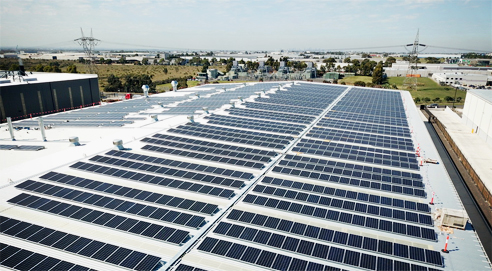Energy Positive Building with Kingspan Insultation

From Net Zero to Energy Positive: The future of energy efficient buildings.
Climate change is a hot button issue across many industries. Today, approximately 30% of global greenhouse gases emitted can be traced back to the built environment, presenting a major opportunity to mitigate climate change. The construction industry has welcomed this challenge and has been making great strides to ensure that buildings are not only energy-efficient, but also capable of self-generating the remaining energy needed to power their buildings. But once this has been achieved, what's next? Brent Trenga, Building Technology Director for Kingspan Insulated Panels, North America, believes that the future of modern construction lies in 'energy positive' buildings.
Trenga thinks that the focus cannot only be getting to net-zero i.e. self-generating enough energy through solar, wind or other renewable technologies to power a buildings needs, but once we get there, what is beyond?
"Going from the term net-zero to net-positive, how do we actually do this. In every context zero is a negative, if I told you something had a sum zero it's not really looked at as a good thing, except maybe your taxes. It's really turning in to how do we get a positive, its giving more than it's taking - energy specific."

Energy positive buildings are buildings that generate more energy than they consume in their entire lifecycle. The design must take into account every building stage, from transport of materials to construction machinery to production, and even its eventual demolition. According to Trenga, there can sometimes be a misconception in the industry around how hard it is to produce energy positive buildings.
"Sometimes we have a tendency to look at a standard building which is 90% of our building stock with huge energy demand and think how could we ever offset that energy consumption. We should be looking at the ultra, high-performance optimised buildings that minimise energy consumption with materials like natural ventilation and natural daylight. Then, if you have a massive commitment to on-site renewables in these buildings, you can get to positive. That's where we should be aiming, where possible."
Energy positive buildings need to be framed in a realistic way. For example, a dense, urban environment may not offer enough space to implement some of the design elements seen in current energy positive buildings. Trenga agrees and thinks that we need to be practical in our approach to this new way of building.
"For certain building types, the typology limits the ability. For example, a hospital would be the hardest thing that we are ever going to get to, in terms of getting a net-positive hospital because their energy demand is so intense. The lower the Energy Use Intensity (EUI) rating the closer you are to zero. If you can build very efficient systems and operate the building at a very low energy demand, that's where we get net positive possibilities."
Even though creating energy positive building can seem like a challenge now - the global industry is setting their heights high to create the most energy-efficient buildings possible, aspiring to energy-positive designs. Trenga believes that taking on the challenge of positive energy buildings is a step in the right direction.
"A lot more people are taking the steps to achieve these things and are willing to take the challenge. Even if you fail, these are great things to fail at. Missing the target is so much better than what you would have done if you hadn't taken the challenge or without going down that road."
Kingspan Insulation operates Australia wide. Contact us to find your local state representative - visit www.kingspan.com.

|





 Underfloor Insulation for Suspended
Underfloor Insulation for Suspended Standing Seam System for 3D Geometric
Standing Seam System for 3D Geometric Australian Steel Water Tank by Kingspan
Australian Steel Water Tank by Kingspan Versatile Roofing for Bold Designs by
Versatile Roofing for Bold Designs by Multi-Groove Panels for the Building
Multi-Groove Panels for the Building Dri-Design Flat Rainscreen Facade
Dri-Design Flat Rainscreen Facade Ocean Debris and Waterway Filtration
Ocean Debris and Waterway Filtration Residential Rainwater Harvesting Tanks
Residential Rainwater Harvesting Tanks Zero Carbon Buildings CPD Webinar by
Zero Carbon Buildings CPD Webinar by R-Value Declaration for Insulation
R-Value Declaration for Insulation Flexible Thermo-cellular Reflective
Flexible Thermo-cellular Reflective Updated AS/NZS Standard for R-values
Updated AS/NZS Standard for R-values 6 Star Green Star Rating for
6 Star Green Star Rating for Thermal Bridging & Total R-Values from
Thermal Bridging & Total R-Values from Underfloor Rigid Board Insulation for
Underfloor Rigid Board Insulation for Compliance Deadline for Soffit
Compliance Deadline for Soffit Specify Compliant Building Products with
Specify Compliant Building Products with New Commercial Insulating Soffit Board
New Commercial Insulating Soffit Board Energy Efficient Homes with Insulation
Energy Efficient Homes with Insulation Flexible Insulation for Double Brick
Flexible Insulation for Double Brick
